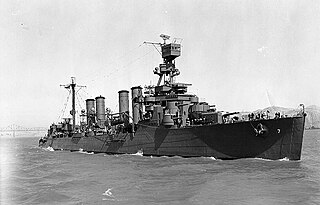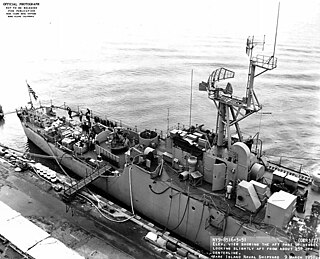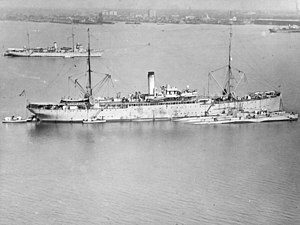
USS Wyoming was the second ship of the United States Navy to bear that name, but the first to bear it in honor of the 44th state. The first Wyoming was named for Wyoming Valley in eastern Pennsylvania.

The third USS Charleston (C-22/CA-19) was a United States Navy St. Louis-class protected cruiser. She was launched 23 January 1904 by Newport News Shipbuilding and Dry Dock Co., Newport News, Virginia, sponsored by Miss Helen Whaley Rhett, and commissioned on 17 October 1905, Captain Cameron McRae Winslow in command. She was reclassified CA-19 on 17 July 1920.

USS Blueback (SS-581) is a Barbel-class submarine that served in the United States Navy from 1959 to 1990, and subsequently was made into an exhibit at the Oregon Museum of Science and Industry. She was the second Navy submarine to bear the name.

USS Abraham Lincoln (SSBN-602), a George Washington-class fleet ballistic missile submarine, was the first ship of the United States Navy to be named for Abraham Lincoln (1809–1865), the 16th President of the United States (1861–1865).

USS Rainbow (AS-7) was the only ship in the United States Navy by that name. The ship was originally converted to a distilling ship in 1898, and then converted again in 1917 to a submarine tender.

The USS St. Louis (C-20/CA-18), was the lead ship of her class of protected cruisers in the United States Navy. St. Louis was launched on 6 May 1905 by the Neafie & Levy Company, of Philadelphia, Pennsylvania. She was sponsored by Miss Gladys Bryant Smith and commissioned on 18 August 1906 with Captain Nathaniel R. Usher in command.

The first USS Philip (DD–76) was a Wickes-class destroyer in the United States Navy during World War I, later transferred to the Royal Navy as HMS Lancaster. She was named for John Woodward Philip.

USS Galveston (C-17/PG-31/CL-19) was a Denver-class protected cruiser in the United States Navy during World War I. She was the first Navy ship named for the city of Galveston, Texas.

USS Raleigh (CL-7) was the fourth Omaha-class light cruiser, originally classified as a scout cruiser, built for the United States Navy. She was the third Navy ship named for the city of Raleigh, North Carolina. The first being Raleigh, a 32–gun frigate built in 1776, during the American Revolution, and captured by the British in 1778. The second was the protected cruiser Raleigh, commissioned in 1894, and decommissioned in 1919.

USS Raton (SS/SSR/AGSS-270), a Gato-class submarine, was a ship of the United States Navy named for the raton, a polynemoid fish inhabiting semitropical waters off the Pacific coast of the Americas.

USS Kanawha (AO–1) was the lead ship of her class of replenishment oilers of the United States Navy. She was commissioned in 1915 and sunk on 8 April 1943 by Japanese aircraft off Tulagi, Solomon Islands.

USS Fox (DD-234/AG-85) was a Clemson-class destroyer in the United States Navy during World War II. She was the fourth ship named for Gustavus Vasa Fox, Assistant Secretary of the Navy during the Civil War.

USS Stoddert (DD-302/AG-18) was a Clemson-class destroyer in the United States Navy following World War I. It was named for Benjamin Stoddert.

The first USS Selfridge (DD-320) was a Clemson-class destroyer in service with the United States Navy from 1921 to 1930. She was scrapped in 1931.

USS Sicard (DD-346/DM-21/AG-100) was a Clemson-class destroyer in the United States Navy following World War I. She was named for Montgomery Sicard.

USS Holland (AS-3) was a submarine tender that served in the United States Navy before and during World War II. Holland was launched by the Puget Sound Naval Shipyard, Bremerton, Washington on 12 April 1926, sponsored by Miss Elizabeth Saunders Chase, daughter of Admiral J. V. Chase, and commissioned on 1 June. Stationed at San Diego, California, tending submarine divisions there with periodic tours to Panama to service submarines based at the Canal Zone pre-World War two. Later serving in the Pacific theatre, by close of hostilities having given 55 instances of refit to submarines, provided repair and service to 20 surface craft and completed various jobs on shore installations.

USS O'Neill (DE-188) was a Cannon-class destroyer escort in service with the United States Navy from 1943 to 1946. In 1950, she was transferred to the Royal Netherlands Navy, where she served as Hr. Ms. Dubois (F809) until 1967. She was scrapped in 1968.

USS Beaver (AS-5) was a submarine tender which served in the United States Navy from 1918 to 1946.

USS Joyce (DE-317) was originally commissioned as a US Coast Guard Edsall-class destroyer escort built for the U.S. Navy during World War II. She served in the Atlantic Ocean and the Pacific Ocean and provided destroyer escort protection against submarine and air attack for Navy vessels and convoys. During its World War II service, on two different engagements with enemy submarines, the Joyce rescued survivors of the tanker SS Pan- Pennsylvania and its sister ship USS Leopold. Joyce received one battle star for its service during World War II.
USS PC-817 was a PC-461-class submarine chaser built for the United States Navy during World War II. She was later renamed Welch (PC-817) but never saw active service under that name.



















